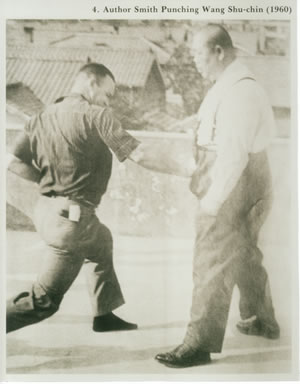 Robert W. Smith punching Wang Shujin in 1960
Robert W. Smith punching Wang Shujin in 1960
Born in 1927, Hidemine Jibiki (地曳秀峰) started training in Okinawan Karate then moved on to Japanese Hakko-ryu Jujutsu and Daito-ryu Aiki-jujutsu. In this section of a four part interview he discusses meeting Wang Shujin, a noted Chinese teacher of Bagua Zhang, Taiji Quan, and Xingyi Quan. Wang was also a leader in a Taoist Sect called the Constant Path (I Kuan Tao).
Wang Shu-Jin had some points of interaction with the Aikido community through American Aikido student Terry Dobson, who trained with him in Japan. Here are two versions of his meeting with Kazuo Chiba, the first from Chiba himself, and the second from Terry Dobson via Ellis Amdur.
Kazuo Chiba’s Version:
Q: …As we are talking about challenges would you mind telling me about your confrontation with Mr Wang, the Tai Chi Master from China?
Chiba: Who told you about this … Mr Cottier perhaps?
Q: Perhaps I’d better not tell …
Chiba: (Laughter) O.K. then. I was in a big demonstration of Martial Arts in Tokyo in the early 1960’s, and Tai Chi Chuan was being shown by Mr Wang. He was from Taiwan and he was very big indeed. He became quite famous later in Japan. Well, at the end of his display he had a number of Karateka line up in front of him, and each of them punched him in the belly. It had no effect on him. I was not impressed. I would have done something else (Sensei demonstrated a groin kick and face punch whilst saying this). So, anyway two of my private students were also studying Tai Chi under Mr Wang, and they were very impressed with him. They invited me to come along and see him. Eventually I accepted and went to watch his class. At the dojo my students introduced us, and he politely asked me to show some Aikido.
Even though his words were warm it was still a challenge! Well, we faced each other, and Master Wang made something like Sumo posture with his hands outstretched. I stood and waited for an opening. This went on for some minutes until he moved forward to push me.
So I met him, made Tai Sabaki (body evasion) and took his wrist with Kote Gaeshi, (wrist crush/reversal) … his wrist made a loud snapping noise as I applied it. Even though I applied Kote Gaeshi strongly and injured him, he did not go down. Master Wang snatched his wrist from me, and challenged me immediately. So this time he pushed me with both hands in the belly, and threw me quite a distance across the room. I landed, but I also did not go down. It was an amazing throw. My students then came between us, and that was that.
Terry Dobson’s version (as told by Ellis Amdur):
I will quote the story that Terry Dobson told me, which was corroborated at another time by Donn Draeger. I also heard Terry tell this story again in a group with Mitsugi Saotome present, who amidst laughter chimed in and agreed. I didn’t know that Ken Cottier was present but he was also part of the group.
Wang started teaching in the grounds of Meiji shrine, and somewhere along the line a group of non-Japanese around Donn Draeger started training with him. Draeger learned some pa-kua, Wang would also show some Hsing I, but mostly he taught TAIJIQUAN. Among this group was Terry Dobson, who was a live-in student of Morihei Ueshiba of aikido. Terry’s direct senior was Chiba. Wang was doing demos in Japanese martial arts demonstrations and as Ken Cottier put it, “here you’d have all these startched Japanese in their crisp keiko gi and their crisp snappy movements and then out would come this fat Chinaman in grey flannel slacks and suspenders and he’d start doing impossible slow TAIJIQUAN and he’d turn around and this ass as big as the moon would waft across the stage and then he’d challenge all comers to have a go at him and the young karate boys would be rabid and he’d let them punch his stomach or kick him in the groin and he’d just laugh it off but heaven help you if you tried to punch his head. He made it clear that that was out of bounds, and if you broke the rules, then he’d become, shall we say, active.”
Terry stated to me, (I’m quoting as best as I can remember) “the uchi-deshi at honbu, particularly Chiba, started giving me a raft of **** that I was being disloyal to O-sensei by studying with Wang, and I asked O-sensei, and he said, ‘sure, do what you want’ but they wouldn’t let up so I said, “why don’t you come and check him out for yourself.” So Draeger and me took Chiba, Saotome and Tamura. Well, we walked in, and Wang scopes out Chiba right away, like he knows who has the attitude here, takes one look, and says, ‘come here boy.’ Seriously, Wang’s over sixty, paid lots of dues, is a religious leader and all, and here comes these punks, as far as he’s concerned, in their twenties, copping an attitude. So Wang lets Chiba punch him in the stomach. Nothing. Chiba tries again. Nothing. Well, now Chiba loses his temper, half turns away, and then tries to sucker punch him, thinking it’s timing. This time Wang sucks the fist into his belly and then drops, he gives it back, Chiba’s arm goes shooting back behind his ear, and he’s shaking his wrist in pain. Wang then let Chiba kick him in the groin. Nothing. So Chiba loses it, grabs Wang’s wrist and puts a nikkyo or kote-gaeshi on it, some wrist lock. I don’t know what Wang did, it was too fast, but Chiba slams on the floor and Wang’s doing something to him with one hand and he’s screaming in pain. Finally Wang lets him up and says, “You’ve got a little chi, why don’t you come back when you acquire more?” Then he turns to Tamura and Saotome, who were standing there with their backs against the wall, and says, “you want to try.” They both shake their heads and we all went home. They never gave me **** about Wang again. . . . Far as I’m concerned, Chiba lost his chance at salvation right there. He should have quit everything and sat at Wang’s feet.
This is the third part of an excerpt from an interview in Japanese with Hidemine Jibiki, in which he discusses meeting the famous Chinese martial artist Wang Shujin. You may want to read Part 1 | Part 2, in which he discusses his experiences in Daito-ryu with Tsunejiro Hosono Sensei and Kotaro Yoshida Sensei, and his experiences with Hakko-ryu Jujutsu Founder Ryuho Okuyama, before reading this section.
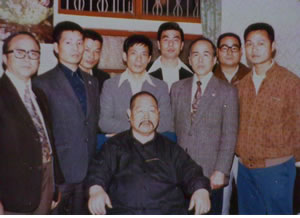 At Wang Shujin’s home
At Wang Shujin’s home
Wang Shujin (王樹金) center, Hidemine Jibiki (地曳秀峰) third from right
Meeting Wang Shujin Roshi
Hidemine Jibiki was doing nothing but Aikido shugyo, day in and day out, but had became aware through the newspapers that a giant of Chinese Kenpo was coming to Japan. This was his chance to make the acquaintance of Wang Shujin Roshi.
Encountering the Chinese Martial Arts
Q: Why did you first develop an interest in the Chinese martial arts?
A: It was at a used bookshop in Kanda in my mid-twenties. I was employed at an American military base as a translator, so I went looking for books in English that would be useful to my work. There were pictures with training scenes of Chinese military advisors in the English magazine “Life”, and I saw them doing some unusual types of martial arts. I think that it was something that had been published in America during the war. Someone in the Allied occupation forces (after the war Japan was temporarily controlled by American military occupying forces) must have left it behind. Now I think that I should have bought it, because that picture made a great impression on me.
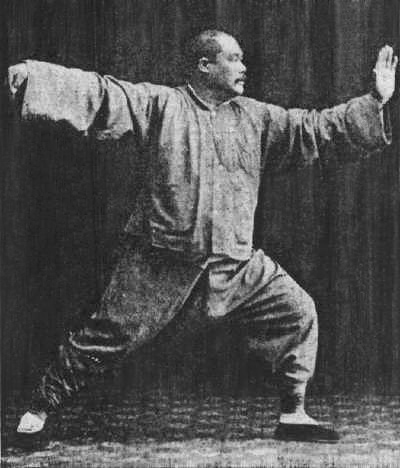 Yang Chengfu demonstrates the Single Whip
Yang Chengfu demonstrates the Single Whip
Q: Was this when you were training in Karate?
A: That’s right. This when I thought that Karate was the best and most rational form of Budo. I started Daito-ryu Aiki Budo when I was around twenty-seven, but this was before that. My body was flexible and I was filled with the confidence that there was nothing that I couldn’t do. The pictures were probably Taiji Quan, and as someone who practiced Karate I couldn’t grasp the point of what they were doing in the Taiji Quan forms. I couldn’t even imagine how Zabansei (Zuò Pán Bù / 坐盤勢 – “sitting with crossed legs stance”), or Tanben (Dān biān / 単鞭 – “single whip”) would be used. When I first saw it I thought it looked strange and mysterious, and it was that impression that led me to meet Roshi and to the present day.
Chatting with Budo Friends
Q: You saw a newspaper article about Wang Shujin Roshi?
A: That was when I just past thirty years old. Through a series of articles I learned that a giant of Chinese Kenpo had accepted an invitation to come to Japan. The “Life” magazine pictures had left a powerful impression on me, so I thought that I would certainly want to go meet him.
Q: I’ve heard that you talked your Budo friends into going to see Roshi?
A: Well, he was a Budo-ka specially dispatched by the government of the Republic of China, and he was also a foreigner, so I was worried about the language barrier. I was too timid to go by myself. (laughing)
At the time I would go drinking with my friends after Aiki training and things would naturally flower into discussions of Budo, so I proposed that we all go see him. Kazuo Yokota was one of those friends. I had done Karate, and seen the photos of Chinese Kenpo, so I made the proposal enthusiastically, but most of them came from Kobudo arts like Iaido, so they just said uncertainly “Well, if you want to go that badly we’ll go along with you. You can try it if you want.”. (laughing) They were mainly interested in arts that employed the sword, or the staff, so it may be that none of them were as interested in the empty hand arts as I was.
Q: You never practiced Kobudo?
A: At that time I was training in the long and short sword of Daito-ryu, as well as Shuriken, with Tsunejiro Hosono Sensei. Basically speaking, however, I wasn’t really interested in holding any kind of a weapon. I was more interested in how to take them away. It was more as if I practiced to understand the attack of the opponent by understanding the use of weapons. So you could say that our approaches to Budo were different from each other.
 Rembukan Dojo, Tokyo – April 1968
Rembukan Dojo, Tokyo – April 1968
Phil Relnick, back row left
(now teaching Tenshin Sho-den Katori Shinto-ryu in Seattle)
Quinton Chambers, back row second from left
(now teaching Shinto Muso-ryu Jodo in Hawaii)
Capt. Charles (Chic) Eather, back row third from left
Kobayashi, back row right
Donn Draeger, front row left
Takaji Shimizu, front row second from left
Martin Gravestyn, front third from left
Nobuko Relnick, front row right
Face to Face with Wang Shujin Roshi
Q: How did you meet with Wang Shujin Roshi?
A: An article saying that Roshi was staying at the house of Takaji Shimizu (清水隆次) Sensei (the 25th Headmaster of Shinto Muso-ryu Jodo / 神道夢想流枝道), appeared in the newspaper, so we went there. I’m not sure exactly when that was, but I think that we had rolled the up our shirt sleeves, so perhaps it was the beginning of summer? At the time Roshi wasn’t there, so Shimizu Sensei came out to speak with us. He asked us what we wanted, and then told us that we would have to come back another time, so I think that we came back on Sunday the next week. I was at the American military base in Kisarazu on the weekdays, so Sunday was the only day that I was able to go.
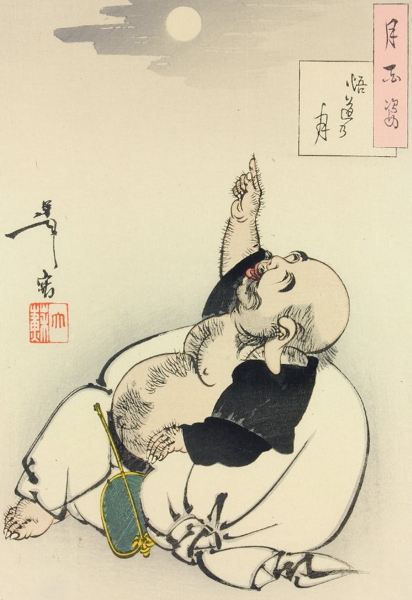 Hotei, of the 7 Lucky Gods – the fat and happy god of abundance and good health
Hotei, of the 7 Lucky Gods – the fat and happy god of abundance and good health
From “One Hundred Aspects of the Moon” (月百姿)
by Tsukioka Yoshitoshi (月岡芳年)
Q: What was your impression of Roshi?
A: He was quite different from what I had imagined. (laughing) Since he was a Kenpo-ka I had envisioned him as lean and fearless, like a Karate-ka or a boxer, but when he came out Roshi was like a plump Hotei-sama – it was very unexpected. (laughing) However, I could not even begin to imagine what came next, I can not even begin to describe it in words. In any case, I told him that I had traveled four hours from Kisarazu to meet him, and feverishly begged him to take me as a student. At the time facilities for travel were quite bad, and it would take a very long time to travel to Tokyo.
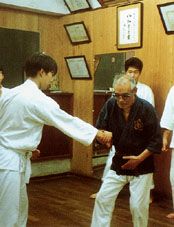 Kinbei Sato, a student of Kakuyoshi Yamamoto
Kinbei Sato, a student of Kakuyoshi Yamamoto
Teaching Daito-ryu Aiki Budo
Q: You received Roshi’s permission immediately?
A: Yes. He told me to come to the 6:30 a.m. training at Meiji Jingu. Mr. Kinbei Sato (佐藤金兵衛) also went to the morning practices, but it was impossible to make it to the morning practices from Kisarazu. Sunday mornings I was working as the Shihan-dai at Hosono Dojo, so when I asked him if it would be possible to train after that he made a special exception so that I could train at the Toyama Dojo. Even further, Shimizu Sensei also made an accommodation for me and I was able to learn the Jo.
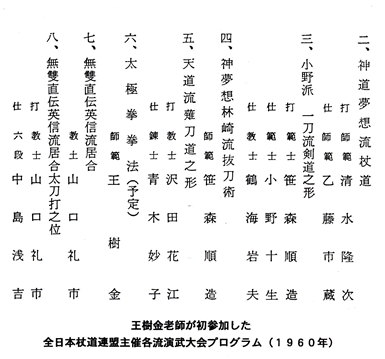 Program for the 1960 Demonstration Featuring Wang Shujin
Program for the 1960 Demonstration Featuring Wang Shujin
Sponsored by the All Japan Jodo Federation (全日本杖道連盟)
At the Toyama Dojo
A: When I think of it now, it was because I was able to train at the Toyama Dojo that enabled me to deepen my connection with Roshi. It was a blessing.
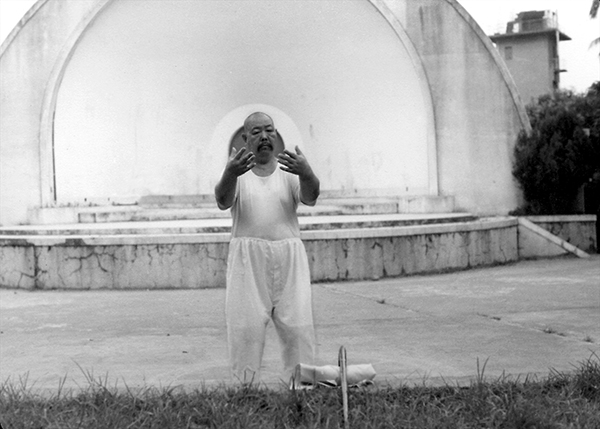 Wang Shujin Demonstrates Pole Standing in Taipei
Wang Shujin Demonstrates Pole Standing in Taipei
Q: What kind of training did you do at the dojo?
A: In any event, Roshi’s training would start with a lot of Chanron (*see note). (laughing) Since it was called Kenpo we had imagined the practice as being something like — if they strike like this then one responds like that, so the others were really disappointed…. (laughing) For myself, while I thought of it as basic training in Kenpo, I really had no idea what was going on and just followed Roshi, doing Chanron in a daze. After that I received instruction in Shinto Muso-ryu Jodo from Shimizu Sensei.
*Note: “Chanron” is a method of “Pole Standing” (姑椿) Kikou (気功 / Qigong) , used here to mean Taisei Kikou (大成気功). In Mandarin it is pronounced “Zhan Zhuang”, but Wang Shujin Roshi, who was born in Tianjin (天津), pronounced it as “Chanron”. Roshi said that there was no meaning in teaching the kata of Taiji Quan or Xing Yi Quan to those who had not built a firm base of Gong Fu (the Ki which is the foundation of Bujutsu). Chanron was stressed from the beginning levels for the cultivation of Gong Fu.
Q: Is it true that your view of Budo became broader after training at Toyama Dojo?
A: People from many different Kobudo gathered at Shimizu Sensei’s place, and it broadened my horizons. Also, the Jo uses the sword as a partner. Since one can’t use the sword unless they understand it I also did Uchitachi with the sword.
I looked forward to going out drinking with my companions after training. (laughing) There was a river where the Shibuya highway is now, and the Harmonica Yoko-cho (ハモニカ横丁) shopping street was near there with a metal roofed Yakitori shop. We were regulars! (laughing)
They would talk about many things, and my interest in experimenting would start to grow. However, my focus was on the empty hand, so I would take in those things from the perspective of empty hand arts. It was if the empty hand arts were my main dish, but the number of side dishes would gradually increase… (laughing)
Q: How did training with Wang Shujin Roshi progress?
A: Even when Wang Shujin Roshi came to stay in Japan he would go home after one or two months. I think that it may have been related to his visa or something…
After that, we’d never know when he was coming back, so one of the reasons why we went to Shimizu Sensei’s place was that if we went there we’d be able to learn about Roshi’s schedule.
However, we were fortunate in that he’d teach us a lot of things in a short time, since he couldn’t make a long term stay. We did Taiji Quan, and he also taught us Xing Yi Quan. At the time, however, we did not really understand the real meaning of those things, or just how incredible the content of the training really was. I had also done Karate, so it was easy for me to do things like the kata in Xing Yi Quan. But one cannot understand striking with Ki just from kata. It might be said that I had some relative understanding of “Ki” from doing Aiki, but I think that my Ki itself had not yet been developed. Because it takes a long to really develop one’s Ki. (laughing) Because of my habits from Karate, at the time I was doing Xing Yi Quan with all of my strength! (laughing)
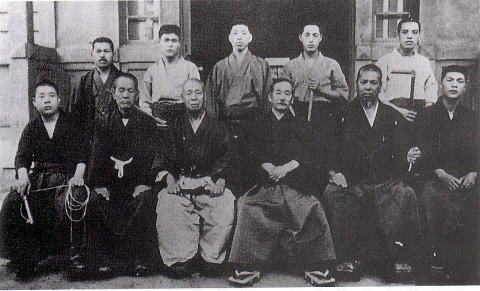 Kusarigama Class (鎖鎌)
Kusarigama Class (鎖鎌)
Front row left: Takaji Shimizu, 25th Headmaster of Shinto Muso-ryu Jodo
Front row third from left: Hanjiro Shiraishi (白石範次郎), Shinto Muso-ryu Jodo
Front row fourth from left: Judo Founder Jigoro Kano (嘉納治五郎)
Back row fourth from left: Kiroku Takayama (高山喜六), Shinto Muso-ryu Jodo
Shinto Muso-ryu Jodo’s Takaji Shimizu Shihan
Hidemine Jibiki began training at Toyama Dojo, and in addition to Wang Shujin also receives instruction from Shinto Muso-ryu Jodo’s Takaji Shimizu Shihan.
Forging a Foundation for Budo
Q: Previously you stated that your knowledge of Budo deepened after beginning to train at Toyama Dojo?
A: That’s right. That period was a time when I was entranced by the astounding techniques of Daito-ryu Aiki Budo, a time when I would forget to eat while conducting my research. Rain or shine, I couldn’t get Aiki out of my head.
Although I could begin to understand how incredible the techniques of Wang Shujin Roshi were I was not able to fully comprehend the techniques themselves. But I could understand that Chanron (Taisei Kikou) was the platform upon which Roshi’s Bugei was built.
Q: What about your companions?
A: Well, I guess that there was a difference in perception. They just came along to keep me company… (laughing)
Their interest, what they discussed with enthusiasm after training, was in things like what to do if someone attacked with some Ryu’s technique, and how to respond. (laughing) When I think of it now, I went because I had the desire and became a student, so from the beginning our motivations were different.
Q: What was so incredible about Wang Shujin Roshi’s techniques?
A: Roshi was aware that I had been training in Aiki, so he told me to try applying something. However, when I reversed his joints he’d just spin and slip right out. Then he’d send me flying with a single light tap.
Just to see such a thing with my own eyes was incredible. I thought that here was a person who had really build a firm foundation for their Budo. I learned just how important that foundation is from Roshi.
Learning from the Masters
Q: It is thought to be difficult to learn from those masters who surpass human understanding…
A: That may be true.
However, there was comfort in participating in Wang Shujin’s training.
At that time I was working at the Daito-ryu Aiki Budo dojo of Tsunejiro Hosono in Koiwa (Edogawa Ward in Tokyo) as a Shihan-dai, in the afternoon I would practice Taiji Quan and Jodo at the Toyama Dojo, and then on Sunday evening I would return to Kisarazu, where I was employed . It was an extremely busy life.
On the weekend, after work, I would do Taiji Quan and Kikou, and swing a Jo hundreds of times while doing Shinto Muso-ryu’s foundational training. This was the period when I learned most about the importance of the foundation of Budo.
Tsunejiro Hosono Sensei was a master of Yawara (Translator’s Note: another name for Japanese empty hand martial arts), and I thought that I wanted to become like Sensei as quickly as possible. The techniques of Yawara were just so mysterious that I couldn’t resist them….curiosity was the driving force behind it all.
Published by: Christopher Li – Honolulu, HI


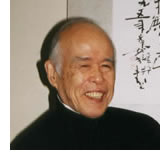


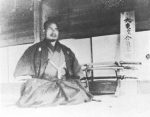



Leave a Reply